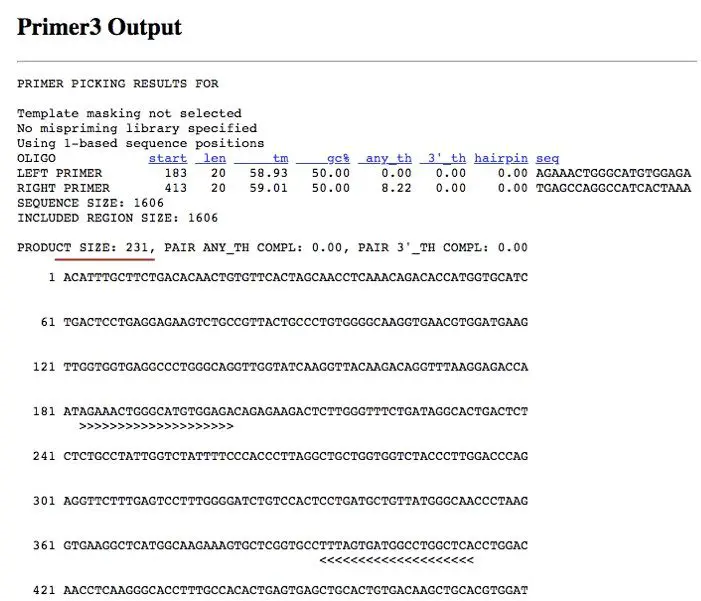The purpose affects the primer design. Sequencing primers must be able to anneal to the target DNA in a predictable location and on a predictable strand.

Minimalist Graphic Design Golden Rules Graphic Design Rules Minimalist Graphic Design Tutor Minimal Graphic Design Graphic Design Tutorials Typography Tutorial
However primers do not need to correspond to the template.

Rules of primer design. Tms between 55-80 o C are preferred. Melting temperature 55 o-65 o C. Primer melting temperature Tm.
However specifying a larger mismatch value may make it more difficult to find such specific primers. Primers should end 3 in a G or C or CG or GC. The annealing temperature of the primer between 55 C to 65 C with 50 GC perform better.
The larger the mismatches especially those toward 3 end are between primers and the unintended targets the more specific the primer pair is to your template ie it will be more difficult to anneal to unintended targets. Another important factor in designing the primer is GC content. The ideal primer generally has the following characteristics.
This requires at least one primer for a given primer pair to have the specified number of mismatches to unintended targets. Primer Premier follows all the guidelines specified for PCR primer design. Some thoughts on designing primers.
Melting temperature T m between 55 and 65C usually corresponds to 45-55 GC for a 20-mer. Their length should be between 18 and 25 base pairs. They are synthesized chemically by joining nucleotides together.
Avoid primers with long runs more than 4 of a single base. GC content of primers. S M Shamsul Islam.
Primers should be 17-28 bases in length. If you are confused by the strands and primer orientation read this. Avoid primers with long polyG or polyC stretches that can promote non-specific annealing.
General rules for primer designing GC content repeats and runs Primer GC content Optimal GC content. GC content between 40 to 60 is acceptable. Parameters such as the PCR product length and the locations of the primers largely depend on the purpose.
One needs to design primers that are complementary to the template region of DNA. Here are some guidelines for designing and using primers in your PCR. Base composition should be 50-60 GC.
The criterion that you have to carefully monitor are. 45-55 Common GC content range. Contig analysis and design of sequencing primers.
They furthermore must be capable of extension by Taq DNA Polymerase. Avoid primers with secondary structures or that can hybridize to form dimers or hairpins. 3-ends of primers should not be complementary ie.
If GC content is too high at given annealing temperature primer will mismatch with other sequences. You can find many primer designing rules online. Primer design is the most important factor in determining the success or failure of PCR.
The 5-end primer overlaps with the 5-end of the gene of interest and should contain the. This brings up the rule of extremes in primer design. Design of the 5-end primer.
Importantly less GC content towards 3 end of primers as it will reduce the chance of mismatch. If you are performing seamless PCR cloning with our In-Fusion Cloning products here are some specific primer design tips for this application. Primer Premier can be used to design primers for single templates alignments degenerate primer design restriction enzyme analysis.
Additionally GC reach sequences are highly non-specific. These can be easily predicted if a primer design program is used such as primer select. The GC content of a primer should be between 40 and 60.
One must selectively block and unblock repeatedly the reactive groups on a nucleotide when adding a nucleotide one at a time. 40-60 Runs single base stretches Long runs increases mis-priming non-specific annealing potential The maximum acceptable number of runs is 4 bp Repeats consecutive di-nucleotide Repeats increases mis-priming potential The maximum. Avoid polyA and polyT as these will breath and open the primer-template complex.
This prevents breathing of ends and increases efficiency of priming. Basic Rules of Primer Design Make sure that the primers are not self-complementary or complementary to the other primer in the reaction mixture as this will encourage the formation of hairpins and primer-dimers and will compete with the template for the use of primer and reagents. The main property of primers is that they must correspond to sequences on the template molecule must be complementary to template strand.
Ideally between 55-65C and Tm between both primers should not differ by more than 5C. The rules for designing primers and probes in a digital PCR assay are similar as for a qPCR assay. Base pair as otherwise primer dimers will be synthesised.
Decide the purpose of the primers. The guidelines for qPCR primer design vary slightly.

Schematic Summary Of Arms Pcr Primer Design And Dna Gel Patterns Of The Download Scientific Diagram

Pin By Joep Klijn On Plastic Design Plastic Design Plastic Injection Molding Design

6 Golden Rules To Successful Dashboard Design Dashboard Design Data Dashboard Dashboard Examples

Systems Thinking Video5 Systemic Interventions And Their Leverage Systems Thinking Systems Theory System

Design And Applications In Molecular Biology Research Primer Design Ppt Video Online Download

Pin On Hr Analytics And Big Data Work

Pin On Forensic Genetics 217029780

How To Select Primers For Polymerase Chain Reaction

Real Time Pcr Qpcr Primer Design Using Free Online Software Thornton 2011 Biochemistry And Molecular Biology Education Wiley Online Library

Addgene Protocol How To Design Primers

Addgene What Is Polymerase Chain Reaction Pcr

Https Ru Pinterest Com Fjborsboom Design Insipir Molding Undercuts Plastic Design Mould Design Injection Moulding

Addgene Protocol How To Design Primers

Primer Design Tips For An Efficient Process Primer Design Pcr Primer Design Primer

Gestalt Similarity The Gestalt Principle Of Similarity Is Drawn From This Photo Because Our Eye Groups The Black Rows Of Dots Together Ore Fotografie Design





